Welcome back to my blog!
On Wednesday, in light of the public attention the funeral of Senator Kennedy received, I posted the following comments that I am now adding to my regular Friday post. We are grateful to all those who have contributed their comments in response to that post. Because of the overwhelming number of comments, not all of them will be posted, but those posted fairly represent those received.
Saturday was the 39th anniversary of my ordination to the priesthood, at St. Augustine’s Church in Pittsburgh by Bishop John B. McDowell, who is still going strong today. In the Church’s calendar, the feast day for August 29 is the Beheading of John the Baptist. People usually take note when I tell them that I was professed to religious life on Bastille Day, July 14, and ordained on the feast of the Beheading. Not that I am superstitious.
On Saturday morning I attended the funeral Mass for Senator Edward M. Kennedy. Father Donald Monan, S.J., former president of Boston College, celebrated the Mass and Father Mark Hession, pastor of Our Lady of Victories in Centerville, preached the homily.




The music was outstanding with the Tanglewood Festival Chorus enriching the liturgy along with mezzo-soprano Susan Graham who later sang an absolutely striking rendition of Schubert’s “Ave Maria.” Cellist Yo-Yo Ma graced us with his beautiful solo performance of Bach and later joined Placido Domingo, who sang the “Panis Angelicus.” Placido has a superb voice. I told him how much I like the Zarzuela, the Spanish classical musical theater productions. His family had a troupe that presented Zarzuelas in Mexico and he promised to arrange a performance.
The venue for the funeral Mass was Mission Church, the magnificent Redemptorist Basilica of Our Lady of Perpetual Help.
Senator Kennedy prayed often in this church when his daughter, Kara, was stricken with cancer. It is a church where countless faithful have gone to pray and ask for healing, grace and forgiveness.
In light of these themes, I wish to address our Catholic faithful who have voiced both support and disappointment at my having presided at the Senator’s funeral Mass.
Needless to say, the Senator’s wake and Catholic funeral were controversial because of the fact that he did not publically support Catholic teaching and advocacy on behalf of the unborn. Given the profound effect of Catholic social teaching on so many of the programs and policies espoused by Senator Kennedy and the millions who benefitted from them, there is a tragic sense of lost opportunity in his lack of support for the unborn. To me and many Catholics it was a great disappointment because, had he placed the issue of life at the centerpiece of the Social Gospel where it belongs, he could have multiplied the immensely valuable work he accomplished.

The thousands of people who lined the roads as the late Senator’s motorcade travelled from Cape Cod to Boston and the throngs that crowded the Kennedy Library for two days during the lying in repose, I believe, were there to pay tribute to these many accomplishments rather than as an endorsement of the Senator’s voting record on abortion.



The crowds also were there to pay tribute to the Kennedy family as a whole. On the national political landscape, if Barack Obama broke the glass ceiling of the presidency for African Americans, Jack Kennedy broke it for American Catholics.
As a young lad, I saw photographs of both Pope John XXIII and President John Kennedy hanging in the thatched cottages of County Mayo and heard the Gaelic greeting, “God and Mary be with you.” Three of the Kennedy brothers died in service of our country in the prime of life. And Eunice Shriver, who died just a few weeks ago, was an outspoken defender of the unborn and an apostle of the Gospel of Life. She taught us all how to love special children and to make room for everyone at the table of life. In 1992, Eunice petitioned her party’s convention to consider “a new understanding” of the issue, “one that does not pit mother against child,” but instead seeks “policies that responsibly protect and advance the interest of mothers and their children, both before and after birth.”
Much of what is noble in the politics and work of the Kennedys had its origins in the bedrock of the faith of Rose Fitzgerald Kennedy. As a young woman she had a profound experience of God’s love that transformed her life. She strove to communicate that faith to her large clan. Since the time of her funeral Mass I have kept her memorial prayer card, inscribed with Rose Kennedy’s own words:
“If God were to take away all His blessings, health, physical fitness, wealth, intelligence, and leave me but one gift, I would ask for faith – for with faith in Him and His goodness, mercy, love for me, and belief in everlasting life, I believe I could suffer the loss of my other gifts and still be happy – trustful, leaving all to His inscrutable Providence.”

There are those who objected, in some cases vociferously, to the Church’s providing a Catholic funeral for the Senator. In the strongest terms I disagree with that position. At the Senator’s interment on Saturday evening, with his family’s permission, we learned of details of his recent personal correspondence with Pope Benedict XVI. It was very moving to hear the Senator acknowledging his failing to always be a faithful Catholic, and his request for prayers as he faced the end of his life. The Holy Father’s expression of gratitude for the Senator’s pledge of prayer for the Church, his commendation of the Senator and his family to the intercession of the Blessed Mother, and his imparting the Apostolic Blessing, spoke of His Holiness’ role as the Vicar of Christ, the Good Shepherd who leaves none of the flock behind.
As Archbishop of Boston, I considered it appropriate to represent the Church at this liturgy out of respect for the Senator, his family, those who attended the Mass and all those who were praying for the Senator and his family at this difficult time. We are people of faith and we believe in a loving and forgiving God from whom we seek mercy.

Advocating for the dignity of life is central to my role as a priest and a bishop. One of my greatest satisfactions in my ministry thus far was helping to overturn the abortion laws in Honduras. The person who answered my call for help with that effort was Dr. Bernard Nathanson, who had been a prominent leader in NARAL and the abortion rights movement. His own change of heart led Dr. Nathanson from a practice of providing abortions to becoming one of the most eloquent exponents of the pro-life movement.
Helen Alvaré, who is one of the most outstanding pro-life jurists, a former Director of the Bishops´ Pro-life Office and a long standing consultant to the USCCB Committee for Pro-Life Activities, has always said that the pro-life movement is best characterized by what it is for, not against. We are for the precious gift of life, and our task is to build a civilization of love. We must show those who do not share our belief about life that we care about them. We will stop the practice of abortion by changing the law, and we will be successful in changing the law if we change people’s hearts. We will not change hearts by turning away from people in their time of need and when they are experiencing grief and loss.
At times, even in the Church, zeal can lead people to issue harsh judgments and impute the worst motives to one another. These attitudes and practices do irreparable damage to the communion of the Church. If any cause is motivated by judgment, anger or vindictiveness, it will be doomed to marginalization and failure. Jesus’ words to us were that we must love one another as He loves us. Jesus loves us while we are still in sin. He loves each of us first, and He loves us to the end. Our ability to change people’s hearts and help them to grasp the dignity of each and every life, from the first moment of conception to the last moment of natural death, is directly related to our ability to increase love and unity in the Church, for our proclamation of the Truth is hindered when we are divided and fighting with each other.
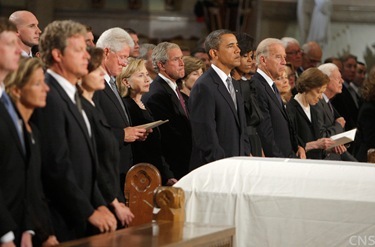
President Obama and three former presidents attended Senator Kennedy’s funeral. I had the opportunity to speak briefly with President Obama, to welcome him to the Basilica and to share with him that the bishops of the Catholic Church are anxious to support a plan for universal health care, but we will not support a plan that will include a provision for abortion or could open the way to abortions in the future. The President was gracious in the short time we spoke, he listened intently to what I was saying.

Democrats and Republicans sat side by side in the Basilica of Our Lady of Perpetual Help, praying for Senator Kennedy and his family. It is my sincere hope that all people who long to promote the cause of life will pray and work together to change hearts, to bring about an increased respect for life, and to change laws so as to make America a safe place for all, including the unborn.
– – –
I spent Monday in Colorado where I officiated at the marriage of my sister, Mary.
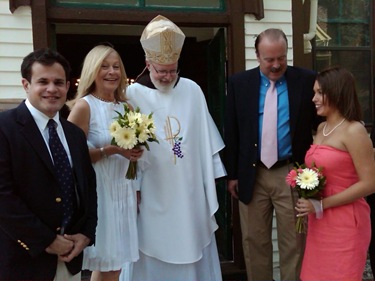
This photo shows Mary and Craig Woods, her new husband
I was very happy to be with my family on this joyous occasion. We pray that the Lord will bless their marriage.
– – –
On Wednesday, I attended the Mass of the Holy Spirit and a cookout at St. John’s Seminary. This year, we have about 100 students at St. John’s and the enrollment continues to grow.
We’re very enthusiastic about the wonderful spirit. The seminary’s rector, Father Arthur Kennedy, in his welcoming remarks, reminded us that this is the 125th class to enter St. John’s, and this year will be a year of special anniversary celebrations.
– – –
Over the last week I have had a chance to go through some more of the many photos we took on our recent visit to Cuba as part of U.S. bishops conference delegation. I want to share them with you:
![clip_image002[4] clip_image002[4]](https://cardinalseansblog.org/wp-content/uploads/2009/09/clip_image0024.jpg)
With Father Emilio Biosca, OFM Cap., a great friend of mine. Capuchins who work in the tropics sometimes wear white
![clip_image004[6] clip_image004[6]](https://cardinalseansblog.org/wp-content/uploads/2009/09/clip_image0046.jpg)
The cloister garden of the “Casa Sacerdotal” which was formerly a Convent for Nuns.
![clip_image006[4] clip_image006[4]](https://cardinalseansblog.org/wp-content/uploads/2009/09/clip_image0064.jpg)
![clip_image008[4] clip_image008[4]](https://cardinalseansblog.org/wp-content/uploads/2009/09/clip_image0084.jpg)
![clip_image010[4] clip_image010[4]](https://cardinalseansblog.org/wp-content/uploads/2009/09/clip_image0104.jpg)
We visited a new monastery of Benedictine Monks who are mostly from Africa. This is the first monastic community to be formed in the city of Havana since the Revolution.
![clip_image012[4] clip_image012[4]](https://cardinalseansblog.org/wp-content/uploads/2009/09/clip_image0124.jpg)
Interesting photo of the U.S. Interests Section in Havana. The Cuban authorities put up all those flagpoles in front of the building to block sight of a large ticker that was counting the number of visas the Interests Section was granting to citizens.
![clip_image014[4] clip_image014[4]](https://cardinalseansblog.org/wp-content/uploads/2009/09/clip_image0144.jpg)
We visited a church that was being restored after its roof collapsed following last year’s hurricane. This restoration has been paid for by the Collection for the Church in Latin America.

You can see the broken windows over the main door that still haven’t been repaired

We were able to bring much-needed medical supplies to the local communities down there. The pastor of this parish was extremely grateful for the supplies, as they are very hard to find in Cuba.

Meeting with Ricardo Alarcón, a prominent Cuban statesman

A photo of members of the delegation who met with Mr. Alarcón

This parish was built and is staffed by the Capuchins. I often joke that this province built the largest Churches – and this Church happens to be the largest Church in Havana!
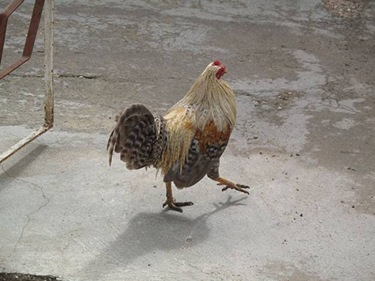
In Holguin – very different from Havana!
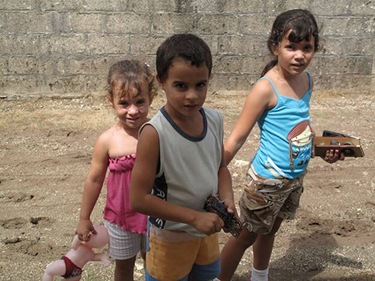
These are some of the neighbors of a Church that was completely destroyed in the hurricanes. Money from the Collection has gone to rebuild their church and the roofs on their homes.
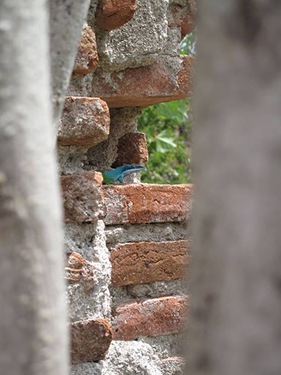
Another neighbor who was very interesting looking…
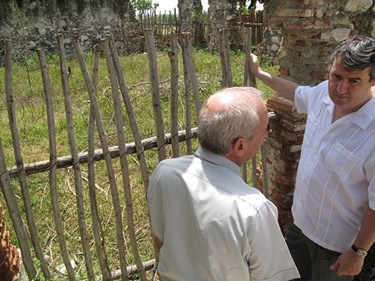
Visiting the site of a former church that was completely destroyed years ago by a hurricane. The Cuban government has not given permission to rebuild, but the façade of the Church remains as a sign of hope.
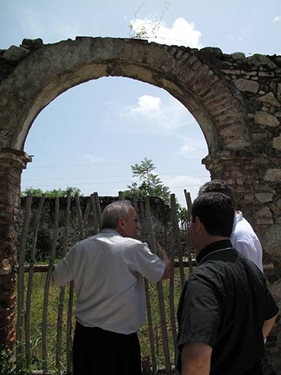
In what was the doorway of the Church
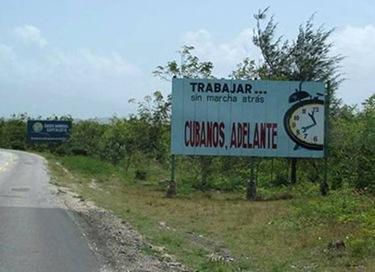
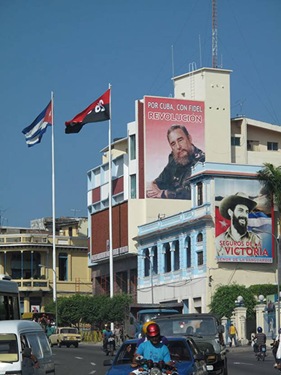
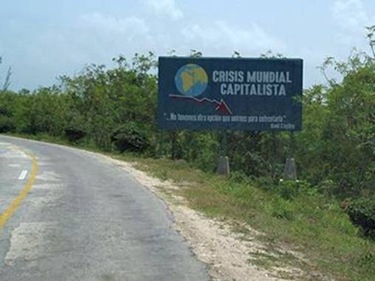
Typical billboards seen throughout Cuba. There are no advertisements. Every billboard is covered with Communist propaganda, and is completely controlled by the authorities.
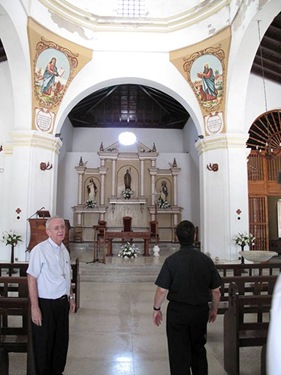
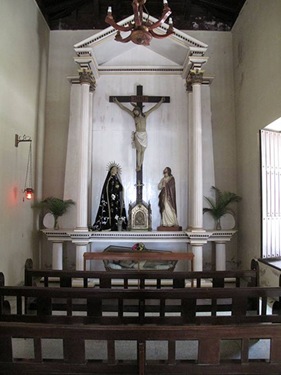
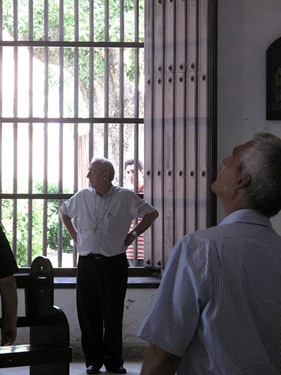
Visiting the Bishop of Holguin in his Cathedral, which was damaged by the water and winds.
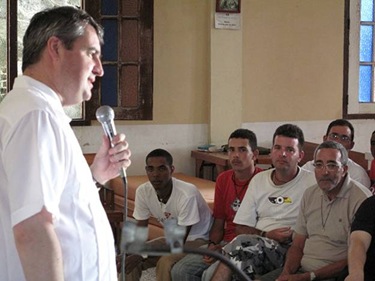
Father Andrew Small and Bishop Oscar Cantu address a group of young Cubans who are walking the island on pilgrimage to the famous Shrine of Nuestra Señora de la Caridad del Cobre
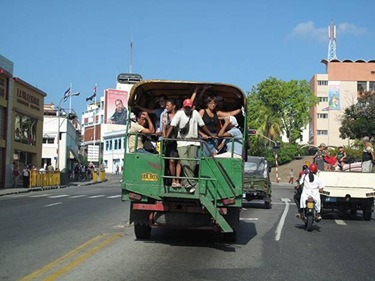
A typical “bus” in Santiago de Cuba
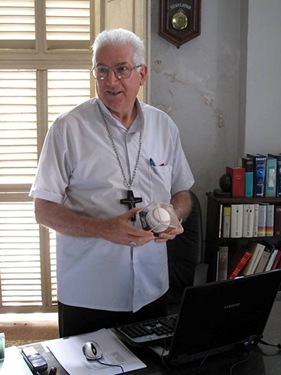
The Bishop of Santiago gave the delegation a very warm welcome; he is most grateful to the Church in the U.S. for their generosity to the Church in Cuba. Many of his churches were completely destroyed, and are being rebuilt now with money collected in the National Collection for the Church in Latin America.
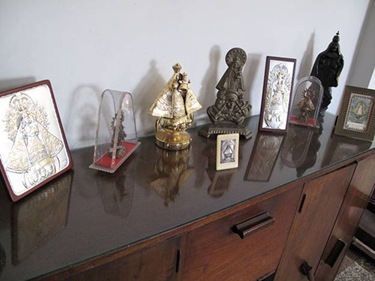
The Bishop’s collection of Images of Nuestra Señora
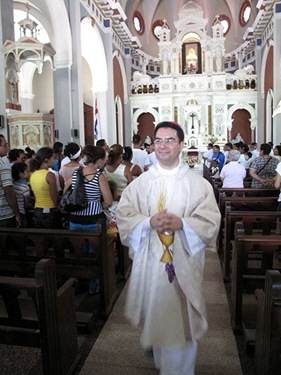
Bishop Cantu preached at Mass at the Shrine of Nuestra Señora
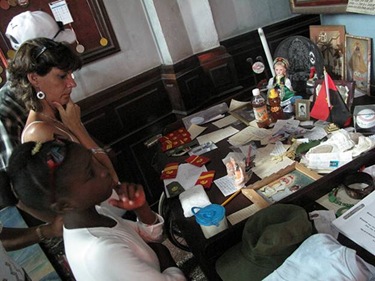
Ex-Votos left at the Shrine
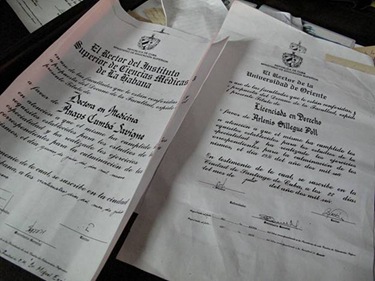
Doctoral theses dedicated to Our Lady – ex votos
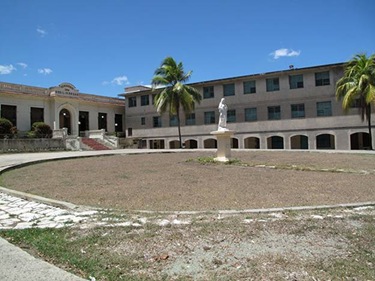
The old Seminary in Santiago
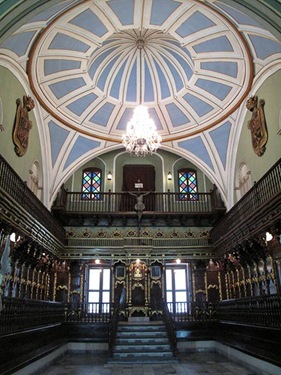
The Cathedral in Santiago was damaged, but the Archbishop of Santiago has been restoring it piece by piece, beginning with the Choir behind the Altar.
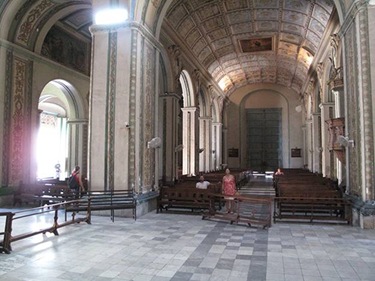
There are whole sections of the Cathedral that are roped off, for fear that the roof will collapse on peoples’ heads.
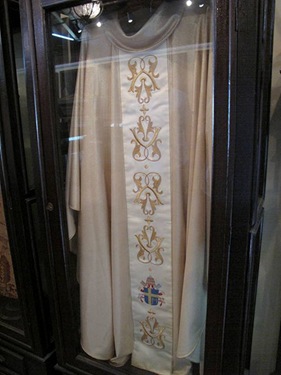
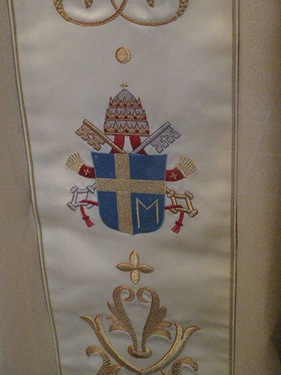
The Chasuble worn by Pope John Paul II during his historic visit to Cuba
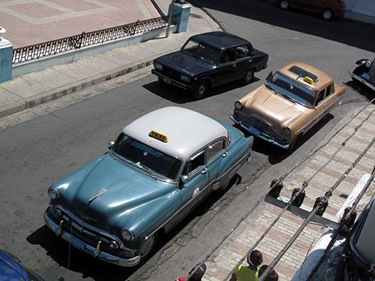
Yes, there really are 50’s era American cars still in use in Cuba, such as these taxi cabs
– – –
Until next week, I wish you a safe and blessed Labor Day holiday!
Cardinal Seán

